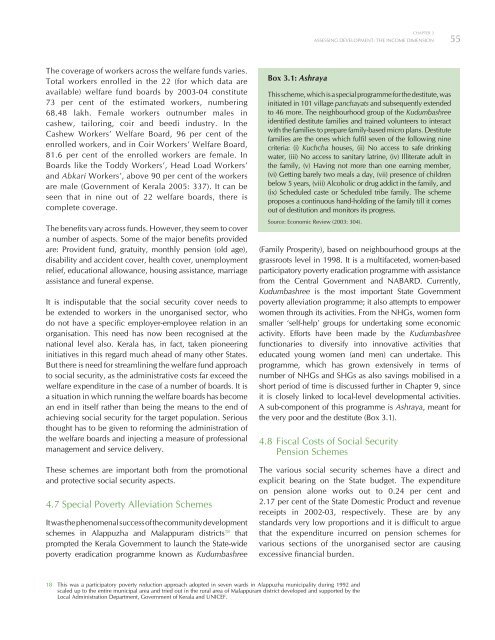Kerala 2005 - of Planning Commission
Kerala 2005 - of Planning Commission
Kerala 2005 - of Planning Commission
Create successful ePaper yourself
Turn your PDF publications into a flip-book with our unique Google optimized e-Paper software.
CHAPTER 3<br />
ASSESSING DEVELOPMENT: THE INCOME DIMENSION<br />
55<br />
The coverage <strong>of</strong> workers across the welfare funds varies.<br />
Total workers enrolled in the 22 (for which data are<br />
available) welfare fund boards by 2003-04 constitute<br />
73 per cent <strong>of</strong> the estimated workers, numbering<br />
68.48 lakh. Female workers outnumber males in<br />
cashew, tailoring, coir and beedi industry. In the<br />
Cashew Workers’ Welfare Board, 96 per cent <strong>of</strong> the<br />
enrolled workers, and in Coir Workers’ Welfare Board,<br />
81.6 per cent <strong>of</strong> the enrolled workers are female. In<br />
Boards like the Toddy Workers’, Head Load Workers’<br />
and Abkari Workers’, above 90 per cent <strong>of</strong> the workers<br />
are male (Government <strong>of</strong> <strong>Kerala</strong> <strong>2005</strong>: 337). It can be<br />
seen that in nine out <strong>of</strong> 22 welfare boards, there is<br />
complete coverage.<br />
The benefits vary across funds. However, they seem to cover<br />
a number <strong>of</strong> aspects. Some <strong>of</strong> the major benefits provided<br />
are: Provident fund, gratuity, monthly pension (old age),<br />
disability and accident cover, health cover, unemployment<br />
relief, educational allowance, housing assistance, marriage<br />
assistance and funeral expense.<br />
It is indisputable that the social security cover needs to<br />
be extended to workers in the unorganised sector, who<br />
do not have a specific employer-employee relation in an<br />
organisation. This need has now been recognised at the<br />
national level also. <strong>Kerala</strong> has, in fact, taken pioneering<br />
initiatives in this regard much ahead <strong>of</strong> many other States.<br />
But there is need for streamlining the welfare fund approach<br />
to social security, as the administrative costs far exceed the<br />
welfare expenditure in the case <strong>of</strong> a number <strong>of</strong> boards. It is<br />
a situation in which running the welfare boards has become<br />
an end in itself rather than being the means to the end <strong>of</strong><br />
achieving social security for the target population. Serious<br />
thought has to be given to reforming the administration <strong>of</strong><br />
the welfare boards and injecting a measure <strong>of</strong> pr<strong>of</strong>essional<br />
management and service delivery.<br />
These schemes are important both from the promotional<br />
and protective social security aspects.<br />
4.7 Special Poverty Alleviation Schemes<br />
It was the phenomenal success <strong>of</strong> the community development<br />
schemes in Alappuzha and Malappuram districts 18 that<br />
prompted the <strong>Kerala</strong> Government to launch the State-wide<br />
poverty eradication programme known as Kudumbashree<br />
Box 3.1: Ashraya<br />
This scheme, which is a special programme for the destitute, was<br />
initiated in 101 village panchayats and subsequently extended<br />
to 46 more. The neighbourhood group <strong>of</strong> the Kudumbashree<br />
identified destitute families and trained volunteers to interact<br />
with the families to prepare family-based micro plans. Destitute<br />
families are the ones which fulfil seven <strong>of</strong> the following nine<br />
criteria: (i) Kuchcha houses, (ii) No access to safe drinking<br />
water, (iii) No access to sanitary latrine, (iv) Illiterate adult in<br />
the family, (v) Having not more than one earning member,<br />
(vi) Getting barely two meals a day, (vii) presence <strong>of</strong> children<br />
below 5 years, (viii) Alcoholic or drug addict in the family, and<br />
(ix) Scheduled caste or Scheduled tribe family. The scheme<br />
proposes a continuous hand-holding <strong>of</strong> the family till it comes<br />
out <strong>of</strong> destitution and monitors its progress.<br />
Source: Economic Review (2003: 304).<br />
(Family Prosperity), based on neighbourhood groups at the<br />
grassroots level in 1998. It is a multifaceted, women-based<br />
participatory poverty eradication programme with assistance<br />
from the Central Government and NABARD. Currently,<br />
Kudumbashree is the most important State Government<br />
poverty alleviation programme; it also attempts to empower<br />
women through its activities. From the NHGs, women form<br />
smaller ‘self-help’ groups for undertaking some economic<br />
activity. Efforts have been made by the Kudumbashree<br />
functionaries to diversify into innovative activities that<br />
educated young women (and men) can undertake. This<br />
programme, which has grown extensively in terms <strong>of</strong><br />
number <strong>of</strong> NHGs and SHGs as also savings mobilised in a<br />
short period <strong>of</strong> time is discussed further in Chapter 9, since<br />
it is closely linked to local-level developmental activities.<br />
A sub-component <strong>of</strong> this programme is Ashraya, meant for<br />
the very poor and the destitute (Box 3.1).<br />
4.8 Fiscal Costs <strong>of</strong> Social Security<br />
Pension Schemes<br />
The various social security schemes have a direct and<br />
explicit bearing on the State budget. The expenditure<br />
on pension alone works out to 0.24 per cent and<br />
2.17 per cent <strong>of</strong> the State Domestic Product and revenue<br />
receipts in 2002-03, respectively. These are by any<br />
standards very low proportions and it is difficult to argue<br />
that the expenditure incurred on pension schemes for<br />
various sections <strong>of</strong> the unorganised sector are causing<br />
excessive financial burden.<br />
18 This was a participatory poverty reduction approach adopted in seven wards in Alappuzha municipality during 1992 and<br />
scaled up to the entire municipal area and tried out in the rural area <strong>of</strong> Malappuram district developed and supported by the<br />
Local Administration Department, Government <strong>of</strong> <strong>Kerala</strong> and UNICEF.

















